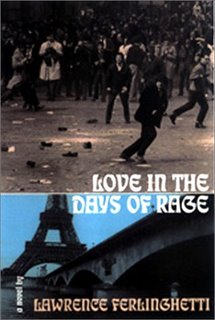
Here's a section from
Love in the Days of Rage, Lawrence Ferlinghetti's whimsical novel set amid the near-revolution in Paris in 1968. The book chronicles a love affair between Annie, an art professor, and Julian, a mysterious anarchist banker; I think it often captures just the right balance between whimsy and verve, love and rebellion. This section is from chapter 14.
Inside the ampitheater, debates were raging twenty-four hours a day, an open tribunal with everyone given the floor, no matter who, from the extreme Right to the extreme Left, militant students demanding democratization of the university and militant nonstudents demanding democratization of everything in society, especially the workplace, so that the amphitheater was becoming what one handbill called “the brain of the cultural revolution,” addressed by Jean-Paul Sartre for an hour and a half, and by seventy-three-year-old Jean Rostand, who was patron of a movement called Jeune Pouvoir that was “against a regime which offered its young neither a future nor liberty.” The hall rocked with Trotskyites, Maoists, anarchists, Situationists, with the statue of Victor Hugo draped in red-and-black anarchist flags, and graffiti quotations everywhere from Lenin, Bakunin, Proudhon, Trotsky, Fourier, Einstein and Che Guevara. Every day the crowd in the amphitheater increased, one paper reporting “10,000 for 5,000 seats.” The Sorbonne had become a free commune with handbills and new journals like Le Pave and Les Revoltes and Le Libertaire. For the spirit of ‘sixty-eight had burst into flame when the rector of the University of Paris called in the riot police to clear the amphitheater, and from that center and from the Nanterre campus in widening circles the fire spread, the revolt spread like a crown fire in a forest, jumping across political lines and boundaries, across class lines and academic distinctions. It was at heart a libertarian revolt of the young, a youth revolt against boring society in general, a global revolt against what they saw as the false values of their elders with their entrenched hierarchies and hereditary authorities backed up by the state and its whole apparatus of control, so that there was a solidarity based not only on youth but on alienation in general, alienation from a fat society that offered its youth no way to enter it. From the university to the factory the “dictatorship of adults” was to be called violently into question, contested at every point, brought to the fire, a contagious and explosive fire that the shock troops of de Gaulle at first knew not how to handle, since they were in fact confronted with the sons and daughters of their own haute bourgoiseie, who were creating their own “open university” as a model for an “open society” where imagination would reign in place of dismal bureaucracy. The special riot squads charged up the Boule Miche with their klaxons and bullhorns and battle gear and tear gas, attacking the sons and daughters of the bourgeoisie that supported the regime. This was the fuse that set off “the days of rage,” with thirty thousand in the barricaded smoking streets by the fifth of May.
 Here's a section from Love in the Days of Rage, Lawrence Ferlinghetti's whimsical novel set amid the near-revolution in Paris in 1968. The book chronicles a love affair between Annie, an art professor, and Julian, a mysterious anarchist banker; I think it often captures just the right balance between whimsy and verve, love and rebellion. This section is from chapter 14.
Here's a section from Love in the Days of Rage, Lawrence Ferlinghetti's whimsical novel set amid the near-revolution in Paris in 1968. The book chronicles a love affair between Annie, an art professor, and Julian, a mysterious anarchist banker; I think it often captures just the right balance between whimsy and verve, love and rebellion. This section is from chapter 14.
0 Comments:
Post a Comment
<< Home